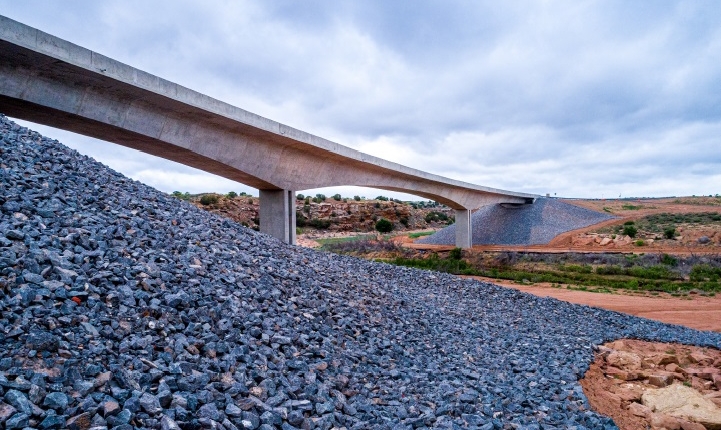US 54 Canadian River Bridge – Logan, New Mexico
In the Village of Logan, the locals will tell you, “We are not the middle of nowhere, but you can see the middle of nowhere from here.” The new US 54 bridge is a source of pride for the community in which it is built. This bridge’s innovation and award-worthiness are demonstrated in the successes achieved due to its remote location, unique environmental constraints, ability to sustain the economic vitality of the adjacent communities, and as New Mexico’s first cast- in-place segmental bridge.
Replacement of the existing steel deck truss bridge was an urgent priority for NMDOT due to the structure’s deficient, fracture-critical, condition. As the need for the project progressed into conceptual development, public engagement was at the team’s forefront.
Innovation of Design and/or Construction
Innovation of design and construction is showcased for this bridge in distinct ways as the project team tailored solutions to the environment in which this bridge was built. Throughout the design and construction, long-term maintenance and durability were high priorities. The project team worked extensively with NMDOT District 4 to fully understand their maintenance needs and challenges, then developed solutions within the design that were practical to the owner’s future care of the bridge and capital budget.
During construction, the work-force pool and availability of workers with bridge construction experience was particularly limited. The full project team approached training proactively to guarantee success. This included the creation of a full-scale segment reinforcement mock-up at the rebar fabricator yard, 3D form traveler equipment training tools for the field crew, and partnership with ASBI to bring ASBI grouting training to the project site to train NMDOT and the project team ahead of grouting operations.
Rapid Construction
An ever-present concern of NMDOT’s Bridge Bureau was the condition of the existing steel deck truss bridge. This structurally deficient structure contains the same typical fracture critical details that have turned close attention to many of the nation’s deteriorating steel bridges. With this consideration, rapid construction was imperative.
The project team proactively addressed efficient and rapid construction by working to streamline construction processes and continually keep the project moving on schedule. This included collaboration on a comprehensive concrete repair plan, advance training and tracking of post tensioning and grouting operations, a seamless geometry control communication process, and quick team action during COVID19.
Aesthetics and/or Harmony with the Environment
Aesthetics and harmony with the environment were identified as another critical element. The environmentally sensitive wetlands around the Canadian River, as well as state- and federally protected species within the river, necessitated a bridge solution that would have no construction impact on these locations. Cast-in-place segmental construction ultimately provided an ideal solution for these environmental challenges. The simplicity and aesthetics of the final structure provide a beautiful balance with the surrounding desert landscape.
Cost Competitiveness
The structure selection process identified the cast-in-place solution as the most cost competitive amid the project criteria. The rural environment presented unique consideration of the structural selection criteria as construction feasibility, cost, and future maintenance had to take special consideration of the remote location and its impact on material, equipment, labor, and costs.
Minimization of Construction Impact on the Traveling Public
Minimizing construction impacts to the community and US 54 users (public and commerce) was of paramount concern. Our engagement led to a new US 54 alignment which swept south of the existing bridge at the river and tied back into the US 54 alignment within the village, providing the village with the commerce it needs.
Jury Comments
This is a fine example of a balanced cantilever cast-in-place segmental bridge. It is the obvious choice given the size and location. The remote location actually worked to the advantage for segmental solution by not having to haul large pieces or use large cranes to set girders. Expect great long-term performance in this environment. A very clean and attractive structure that fits the site well.
2021 ASBI Bridge Award of Excellence
Category: Rural Bridges and Viaducts
State:
New Mexico
Owner:
New Mexico DOT
Owner’s Engineer:
Jacobs Engineering
Designer:
Jacobs Engineering
Contractor:
Malcolm International (Segmental Subcontractor) and Fisher Sand and Gravel
Construction Engineering Services:
McNary Bergeron & Associates
Construction Engineering Inspection:
New Mexico DOT District 4
Form Travelers for Cast-in-Place Segments:
Schwager Davis, Inc.
Post-Tensioning:
Schwager Davis, Inc.
Bearings:
D.S. Brown Company
Expansion Joints:
Watson Bowman Acme
Prepackaged Grout:
US Spec






